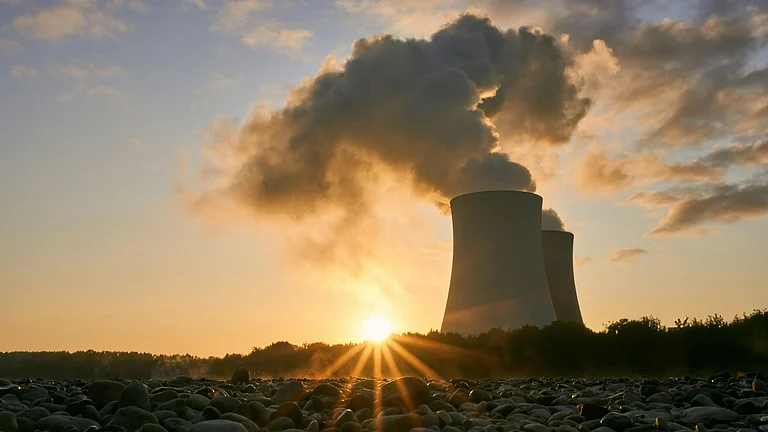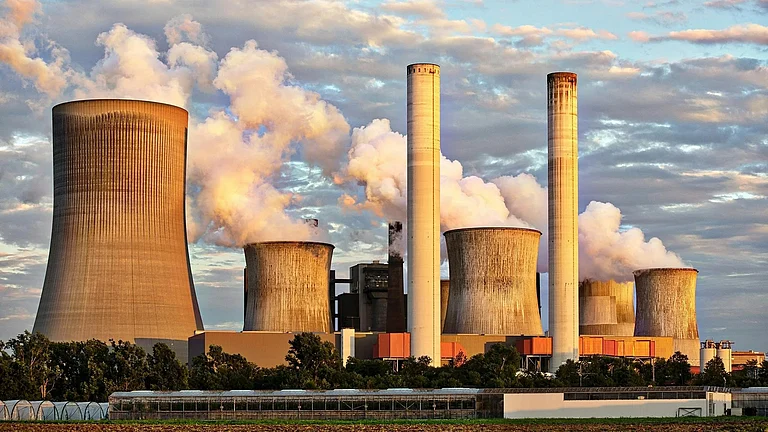While the Narendra Modi-led government’s move to open the civil nuclear energy sector to private players has been hailed as historic, the journey, at least initially, comes with its set of challenges, including amendment in the laws and dependence on the government and foreign companies for technology and talent. The government has started working on the changes required in the legal framework, but ‘how’ and ‘when’ these amendments will be done remain undisclosed.
The nuclear mission announced by Finance Minister Nirmala Sitharaman in her budget 2025-26 speech marked a significant step towards private companies' entry in the sector. Following the announcement, private companies, including Naveen Jindal-led Jindal Nuclear Power, Tata Power and Anil Agarwal-led Vedanta, rushed to show interest in the sector. Billionaire Gautam Adani’s visit to Tarapur Atomic Power Station just a few weeks after the announcement led to speculation that the Adani Group might also be interested in the sector.
Why Government Eyes Private Sector
The government’s move to partner with the private sector is a big development, especially because India’s nuclear tale has largely been scripted by state-owned entities in collaboration with foreign technology partners.
Speaking about the need for opening up the sector, Union Minister of State for Science and Technology, Jitendra Singh said the move aligns with international practices, allowing India to enhance its nuclear power capabilities while reducing dependency on public funds.
“The PM has decided to open up the nuclear sector to private players, ensuring a larger resource pool and faster development,” said the minister in the Parliament.
The last two years have been the most happening years for the country’s civil nuclear energy sector’s liberalisation, mainly due to two crucial factors. The United Nations Climate Change Conference (COP28) for the first time included the role of nuclear power to achieve rapid decarbonisation.
Following this development in 2023, the last two budgets presented by the finance minister, Nirmala Sitharaman, in 2024 and 2025, have been in this direction. Shortcomings of other renewable energy sources, including solar, hydro and wind, like lack of 24/7 power supply, excessive dependence on natural resources and land, and issues with energy storage, have made nuclear an attractive energy solution.
The government has set an aim to increase the country’s nuclear capacity from 8180 MW in January 2025 to 100 GW by 2047 and build at least five indigenously designed and operational Bharat Small Modular Reactors (SMRs) by 2033, according to the Department of Atomic Energy’s (DAE) statement. This is far from what the government had projected in 2011, which was 27,500 MW by 2032, according to the World Nuclear Organisation.
According to the Central Electricity Authority (CEA) 2024 general review, nuclear energy contributes 2.83% of the overall energy generated in India. The government has projected to increase the country’s nuclear capacity from 8180 MW in January 2025 to 100 GW by 2047, according to the DAE’s statement.
Speaking to Outlook Business, nuclear engineer and president of the Indian Youth Nuclear Society (IYNS), Nitendra Singh, said that the opening of the sector has brought opportunities for the private companies, but it will not be short of challenges, especially as the deployment of reactors requires a long gestation period.
“This is an ambitious milestone considering the fact that average reactor deployment time in India currently is 10 years. Several factors contribute simultaneously to this timeline, including changes required in the legal framework that supports the industry,” said Singh.
Regulatory Hurdles Persist
The government has initiated groundwork to build an environment infrastructurally attractive to both domestic and foreign companies, but the final roadblock hasn’t been removed yet. The final entry by the companies can only be made if the government makes amendments to the Atomic Energy Act (AEA) and the Civil Liability for Nuclear Damage Act (CLNDA).
Recently, the External Affairs Minister S Jaishankar also highlighted the same concern.
“...we need to look at the liability law because, clearly, the current law has not instilled confidence in the international nuclear industry,” said the minister at the Global Technology Summit 2025.
The government is aware of the regulatory hurdles and has set up a committee comprising members from the Department of Atomic Energy, the Atomic Energy Regulatory Board, NITI Aayog and the Ministry of Law and Justice to assess the amendments required in the laws to facilitate private players entry.
India’s nuclear energy sector is primarily governed by the provisions of the Atomic Energy Act, which gives public sector companies like the DAE and NPCIL exclusive control. The presence of private companies is restricted to roles such as engineering, procurement, and construction (EPC) services. Operations and research and development (R&D) have been under the government’s strict control.
Another crucial piece of legislation is CLNDA. The act assigns responsibility and ensures compensation in case of any nuclear incident or disaster. While the act was brought in 2010 to protect the interests of victims of such disasters, provisions like the supplier liability clause have become a bottleneck for companies wanting to invest in the sector. Under the clause in case of an accident due to equipment or material defect, the liability can be shifted from the plant operator to the supplier and vendor.
Private Entry with Limited Freedom
The private sector’s entry will be conditional in the sense that they can participate in collaboration with the government. According to DAE’s statement, to develop Bharat Small Reactors (BSRs), the private sector will provide land, cooling water, and capital, whereas the state-owned NPCIL will handle design, quality assurance, and operation and maintenance within the existing legal framework. The projects will be carried out in a public-private partnership (PPP) manner.
Besides this, Indian private companies will have to rely on foreign companies for technology. While Indian companies will mark their debut, foreign companies have a legacy of developing technology and operating in the nuclear sector. Holtec International, an American private company owned by Indian-origin founder Krishna P. Singh, has nearly five decades of experience in the nuclear power industry. Apart from Holtec Asia, French company EDF, Russia’s state-owned Rosatom and America’s Westinghouse will also partner with the government to build small modular reactors (SMRs). The government has worked with these foreign players in the past and they have played a crucial role as suppliers.
India has nuclear agreements with countries, including the USA, Russia, France, UK, South Korea and Canada, for sourcing both reactors and fuel from suppliers in these countries. In the past, foreign and domestic companies had signed agreements to form joint ventures, including Areva’s partnership with Bharat Forge. Hitachi Nuclear Energy (GEH) had an early-stage contract with Tata Consulting Engineers to work on project design and workforce development, according to the London-headquartered World Nuclear Association. Russia’s nuclear firm Atomenergomash was reportedly negotiating with potential Indian companies on localisation of production and design of equipment with Russian technology.
“Currently, India’s technological reliance on foreign companies for advanced reactor designs and technologies highlights the need for concentrated efforts in technology transfer,” Leader, ESG, Climate & Energy, PwC Sambitosh Mohapatra told Outlook Business. Although initially foreign expertise will remain crucial, it will push for local innovation and gradually reduce dependence, Mohapatra added.
Indian companies like L&T, Walchandnagar Industries, TEMA India, Godrej & Boyce Mfg., MTAR Technologies, Reliance Infra, Tata Projects and Kirloskar Brothers have long been present in the sector, but their roles are restricted to design, engineering, procurement, manufacturing, quality assurance, testing, packing and transportation of equipment.
Besides this, L&T and NPCIL have a 74:26 joint venture, L&T Special Steels and Heavy Forgings (LTSSHF), since 2009 to produce steel plants and forging facilities mainly for the nuclear sector.
Commenting on the roles of these companies, former chairman and MD of NPCIL SK Sharma told Outlook Business that these firms' have decades-long experience, and they should now be eyeing to enhance their role to engineering, procurement and construction.
“As a natural corollary, they should now be aspiring for providing complete EPC solutions especially in the emerging SMR sector. With decades-long experience...they have a definite advantage in quickly lowering specific-cost (per MW) of SMRs to the levels comparable with larger water-cooled reactors,” Sharma said.
While India’s dependence on foreign companies for technology is likely to be reduced gradually, another concern for the private companies eyeing the sector is that of necessary talent. With the legacy of the public sector in nuclear energy, the private companies will have an increased dependence on the government for nuclear-specific talent to convert their vision into reality.
Highlighting the skill gap or scarcity for private industry, Singh mentioned that since the industry was not directly a part of the nuclear sector, they lack a workforce on all levels for the said expansion.
“The existing workforce in the power industry can be nuclearised to be part of the upcoming nuclear industry. A dedicated cooperation between industries, academia and policymakers is a key to making it possible. Re-engaging the retired DAE workforce will be another key aspect from knowledge transfer and management point of view,” Singh said.
Despite the warm welcome for the nuclear industry, the journey of private companies so far seems to be coupled with dependency and far from being liberalised.






























